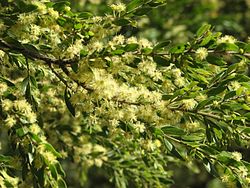Acacia howittii
| Acacia howittii subsp. var. | Howitt's Wattle, Sticky Wattle | |||||||||||||||||||||||||||||||||||||||||||||||||||||||
|---|---|---|---|---|---|---|---|---|---|---|---|---|---|---|---|---|---|---|---|---|---|---|---|---|---|---|---|---|---|---|---|---|---|---|---|---|---|---|---|---|---|---|---|---|---|---|---|---|---|---|---|---|---|---|---|---|

|
|
| ||||||||||||||||||||||||||||||||||||||||||||||||||||||
| ||||||||||||||||||||||||||||||||||||||||||||||||||||||||
Acacia howittii, commonly known as Sticky Wattle or Howitts Wattle, is a tree species that is endemic to Victoria, Australia. It has an erect or spreading habit, growing up to 9 metres high, The phyllodes are up to 2 cm in length. The globular pale-yellow flowerheads appear in the leaf axils in October, followed by straight seedpods that are up to 6 cm long [1]
The species was first formally described by Victorian Government Botanist Ferdinand von Mueller in The Victorian Naturalist in 1893. Mueller's description was based on material collected by Alfred William Howitt, for whom the species is named.[2]
Although regarded as a rare species, it is commonly cultivated, and has become naturalised in areas outside its original range.[1]
Cultivation
Propagation
Pests and diseases
Varieties
Gallery
-
photo 1
-
photo 2
-
photo 3
References
External links
- w:Acacia howittii. Some of the material on this page may be from Wikipedia, under the Creative Commons license.
- Acacia howittii QR Code (Size 50, 100, 200, 500)
